By Jeffrey A. Rendall, Photos By Brad Cheney
Note *** Brad Cheney re-visited the course in May of 2006, and offers his ‘Second Opinion’ at the end of this article.
GAINESVILLE, VA -- “I like to design hard golf courses,” said PB Dye with a chuckle when I asked him what his philosophy was behind creating Virginia Oaks. The course is located about 35 minutes from downtown Washington, DC, and true to Dye’s word, provides quite a challenge to the player who decides to give it a roll. The course probably isn’t as hard as Dye’s other Northern Virginia design--The Gauntlet at Curtis Park--but don’t go to Virginia Oaks thinking it’s going to be a picnic at an amusement park. There aren’t any cotton candy holes here, but there’s enough of a roller coaster ride to give you a thrill.
Measuring 6,928 yards from the back and playing to a par 72, there are plenty of elevation changes, forced carries over water, elevated putting surfaces, steep bunkers and multi-tiered greens to keep you busy for four hours. Boredom is never an option at Virginia Oaks--each hole seems to provide its own unique challenge. Dye puts a premium on accuracy off the tee, and doesn’t let up greenside either. PB should be happy with his product--it’s certainly not easy.
If there’s a knock on the course at all, it’s the setting of some of the holes. While the signature fourth hole spectacularly winds down practically into Lake Manassas, there are several holes where the vistas consist of townhomes and upscale houses. The holes are hardly ruined by their presence, but it’s not as picturesque as it would be without them. One only needs to glance across the lake to the Robert Trent Jones Golf Club, site of the President’s Cup--to see where the potential of the property is. But it’s probably superb for the homeowners!
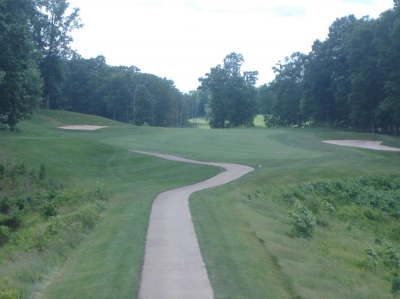 |
| With Lake Manassas on the right side of the fairway, the par five 3rd hole is one of the most beautiful holes on the course. |
All in all, Dye has done an outstanding job carving the course out of what appears to be a very difficult piece of ground. About the land, PB said “I told the developer, Milton Peterson, to ‘plow up the ground and you’ll have a hell of a rock quarry!’” It seems obvious in several spots that a great deal of earth had to be moved in order to shape the hole.
A good example of this is the aforementioned par 4 fourth, Virginia Oaks’ signature hole. The hole plays to 432 yards from the championship tees, and requires a fade on the mildly downhill tee shot. If you don’t get enough distance on the drive, you’ll find a somewhat blind shot into the green, since you’re literally staring at Lake Manssas below you with a green protected by mounds and steep bunkers. There’s little room to run the ball on the green, so you’ll have to gulp hard and do it the high way. Anything long and you’re negotiating with the Kingfish of Lake Manassas for return of the ball. Dye did a superb job of crafting the undulating green--and literally created something out of nothing--that’s where the earth moving comes in.
The tough frontside ends with another Dye signature--his dad’s and PB’s--an island green. Having never been to the TPC at Sawgrass, I can’t say whether the green there’s any larger--all I know is that the ninth at Virginia Oaks doesn’t give a lot to shoot at. 135 yards of water stand between you and the green, and although there isn’t quite the pressure of winning a prestigious tournament piled on your shot--it still rattles the nerves. Dye said he designed the hole to be viewed from the cluhouse deck, where duffers who’ve finished their rounds can watch the oncoming groups have a go at the island--and maybe even place some bets! There’s also an attractive waterfall bordering the hole--very well done.
The backside plays 224 yards longer than the front, but seems to be a fair amount easier. Maybe it’s just because you’ve lived through some tough ones in the first nine. The tenth hole is a unique par five--and that’s not only because it plays to 621 yards--it’s an S shaped hole. The tee shot is downhill, and a good drive will still leave you with a tricky lie for the second. There’s no going at the green here, as there’s a tall stand of trees blocking your way even if you could hit a fairway wood from a downhill lie over three hundred yards. As a result, the second shot is a ‘layup’, where you’ll still need a medium to long iron into the green. As true a three shotter as there ever was. Par here is an excellent score.
As seems to be true with most modern courses, there’s a driveable (or close to it) par 4 at Virgnia Oaks--the twelfth at 310 yards from the back. The tee shot must carry water--but it’s not really in play for anything more than a pure shank. There’s enough of a landing area to temp you to have a go at the green--but unless you’ve played here before, you won’t have an idea what’s there. The green is protected by a large group of mounds, and there’s water on the right that isn’t readily apparent from the tee. This seemingly easy hole no doubt has caught more than a few unsuspecting players by surpirse when what would seem to be good shots disappear into the Twilight Zone. This hole too is signature PB Dye--nothing is ever as easy as it might appear.
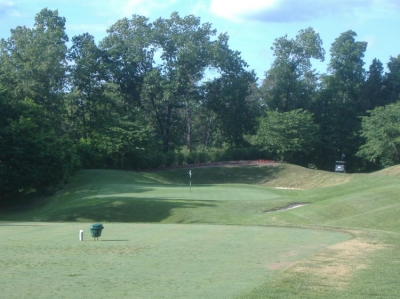 |
| The short par three 15th hole is the easiest on the course and a great opportunity for birdie, provided you hit to the correct part of the green. |
The round ends with the 545 yard par 5 eighteenth. Here, again, Dye calls for accuracy off the tee and the second shots. If you don’t have a short third from the fairway, it might be difficult to hold the green, as it slopes somewhat severely on the edge down towards the water on the left. Here, even a relatively good shot can find the water if it’s in the wrong spot.
The final shot on the final hole sums up the course--it can bite you if you’re not careful. It’s the type of track that needs to be run a few times in order for you to know where to be to avoid the trouble spots. The reasonable rate structure (especially the twilight rates) will allow you to give it a go enough times to find out where you should be. Virginia Oaks certainly deserves to be on the top end of the middle tier of courses in Northern Virginia--and definitely merits a visit--if for nothing else, because it’s challenging!
‘Second Opinions’ by Brad Cheney, June, 2006
Course design and difficulty
P.B. Dye developed a reputation for designing challenging courses a long time ago, and his work at Virginia Oaks does nothing to diminish it. The fairways are narrow, the greens are heavily sloped and quick, and the bunkers are plentiful and deep. Playing at just over 6800 yards from the tips, the course isn’t terribly long. However, numerous dogleg holes discourage big hitters from blasting drivers at every turn, virtually forcing them to choose safer clubs instead.
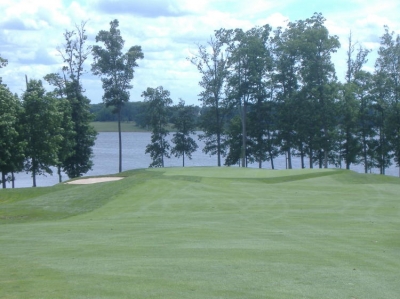 |
| The view of the picturesque green on the 4th hole. This 432 yard downhill par four hole plays shorter than is listed and provides a good birdie opportunity. |
Virginia Oaks General Manager Tim Woodruff acknowledged the course’s intimidating image, and said its difficulty is part of its appeal: “Our layout has a reputation of being difficult from every tee box. There are some holes where you just stand on the tee and say ‘wow, how am I going to play this hole?’ We want players to think par is a good score and birdie is a great score.”
Having done just that, I couldn’t agree more. The narrow fairways place a premium on accuracy off the tee – and occasionally the mounds in the fairways result in awkward lies and unfair bounces. Almost every green features several tiers and severe elevation changes, making club selection and accurate iron play a must.
That stated, the course also provides several good birdie opportunities, including the third hole, a relatively short part five (471 yards from the tips), the seventh hole (336 from the back tees, par four) and hole number twelve (310 yards, par four).
Built alongside Lake Manassas, Virginia Oaks features several holes bordering the water, offering some great views of the lake (and neighboring Robert Trent Jones Golf Club). The water does not come into play on most of these holes, however.
One hole where water does factor in is the par three ninth, which also presents one of the most picturesque scenes on the course. There’s an island green with the clubhouse as a backdrop, providing a beautiful and challenging finish to the front nine. Other favorites included the third and fourth holes, both set on the shore of the lake with few houses to spoil the surroundings.
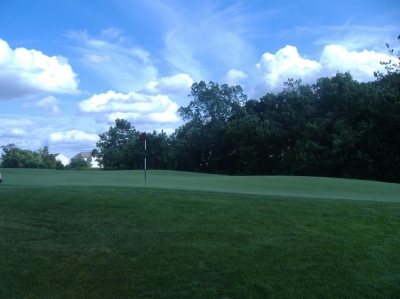 |
| The green on the par three 11th hole is P.B. Dye at his best: several levels, big elevation changes and extremely quick. |
A round at Virginia Oaks was summed up by one fellow golfer, “It might be overwhelming for beginners, but anyone who’s played the game will definitely enjoy the trip.”
Virginia Oaks is located in the midst of a housing development and homes line the fairways of almost every hole. Wayward shots easily find backyards, porches and possibly windows. Therefore, this course probably isn’t the best bet for those with problems hitting it straight.
Course Conditions:
Overall, Virginia Oaks was in excellent condition. The fairways were well maintained and usually provided good lies. There was some standing water in a few spots, however, and the 18th fairway’s drainage system was under renovation.
About the situation on the final hole, Woodruff said “We had some drainage issues on 18 that we needed to address. The work was done about three weeks ago (May, 2006) and should be healed within a few weeks.”
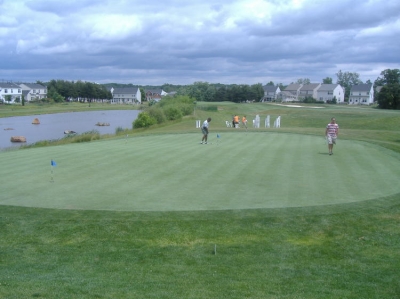 |
| The view of the putting green at Virginia Oaks with the 8th hole in the background. |
Virginia Oaks’ rough is thick and difficult to hit from, suggesting that a lay-up might be the better play from a tough spot, rather than aiming for the green. The bunkers were nicely raked and the sand was consistent from one to another. The greens also were in good condition and rolled very fast. The combination of the greens’ speed and the ‘PB Dye’ slopes made putting on this course very challenging.
Staff and Facilities
Given the peak price of this course ($94), the service was a little below expectations.
“With unfriendly rangers and minimal food options, the service failed to impress,” said one golfer.
Indeed we only saw the beverage cart three times during our round, one of which was on the first hole. Then, due to a wedding, the clubhouse was closed at the turn. Therefore, the only food options on this particular day were ham and cheese sandwiches and pretzels on the drink cart.
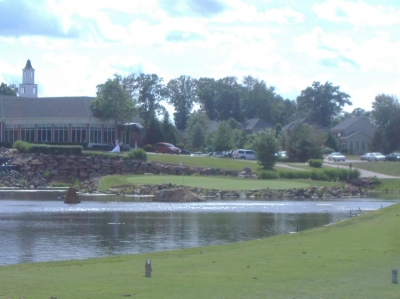 |
| With the clubhouse behind, the island green on the par three 9th hole is a great way to finish the front nine. |
Woodruff addressed the service issues: “This is an area that we’ve been working on since Billy Casper Golf purchased the course last year. Certainly we’re not yet where we want to be, but our goal is to bring the hospitability industry to the golf course and make sure everyone, regardless of when they play, has a positive experience on the course.”
Virginia Oaks does have a driving range, though it is located, in the words of a pro-shop worker, “a long par 5” from the clubhouse. If you want to warm up prior to your round, you should be sure to leave enough time to get to and from the range before your tee-time. Also, range balls are not included in the greens fees, an amenity that courses in this price range usually offer.
The large pro-shop can certainly serve your apparel and equipment needs. The course also has a full training and teaching program catered to individual needs, with lessons ranging from $35 to $65, as well as a Junior Golf Program for youngsters taking up the sport.
For events, the course boasts a full catering department that can accommodate weddings (as we saw) and other functions up to 150 people. They also can host outings and tournaments of any size.
Regular golfers at Billy Casper Golf’s Virginia Oaks and Reston National facilities should consider joining their Virginia Golfers Club, which offers significant discounts for rounds at both courses.
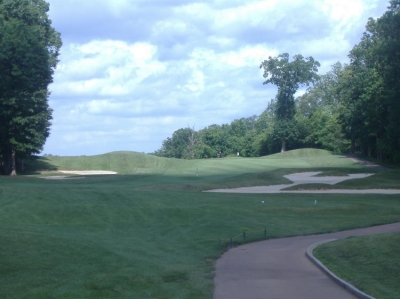 |
| Playing up hill with a narrow fairway and bunkers on both sides of the fairway, the 8th hole provides a challenge to even the most experienced golfer. |
Closing thoughts
Virginia Oaks is a well conditioned, challenging golf course. Experienced golfers will use every club in their bag and definitely enjoy the round. As a word of caution -- given the difficulty of the course and the number of houses lining the fairways, beginners might want to take a few more lessons before braving the grounds at Virginia Oaks.
Details:
7950
Tel: 703.754.7977
Fax: 703.754.4136
Website: www.virginiaoaksgc.com
General Manager: Tim Woodruff
Assistant General Manager: Brian Wilcox
Director of Sales: Jacqueline Jevelle
Course Designer: P. B. Dye
Course Superintendent: Dennis Bowsher
Tees/Yardage/Slope/Rating
Green 6894/136 73.6
Yellow 6405/131 71.6
Black 5985/126 69.8
Silver 4830/115 67.9
Rates:
M-Th: Before 8 am and 11 am – 2pm: $49; 8-11 am: $69; Fri: before 8 am: $49; 8 am -2 pm: $69; Weekends & Holidays: open – 11 am: $94; 11 am – 2 pm: $69
Twilight (after 2): M-Th: $39; Fridays and Weekends & Holidays: $49
Rates include cart fees.
| Related Links | Comments on this article? | |
|
Maryland National Golf Club Hollow Creek Golf Club Rocky Gap Resort PB Dye Golf Club in Ijamsville Whiskey Creek Golf Club |
E-mail Jeff Rendall, Editor: jrendall@golftheunitedstates.com |












